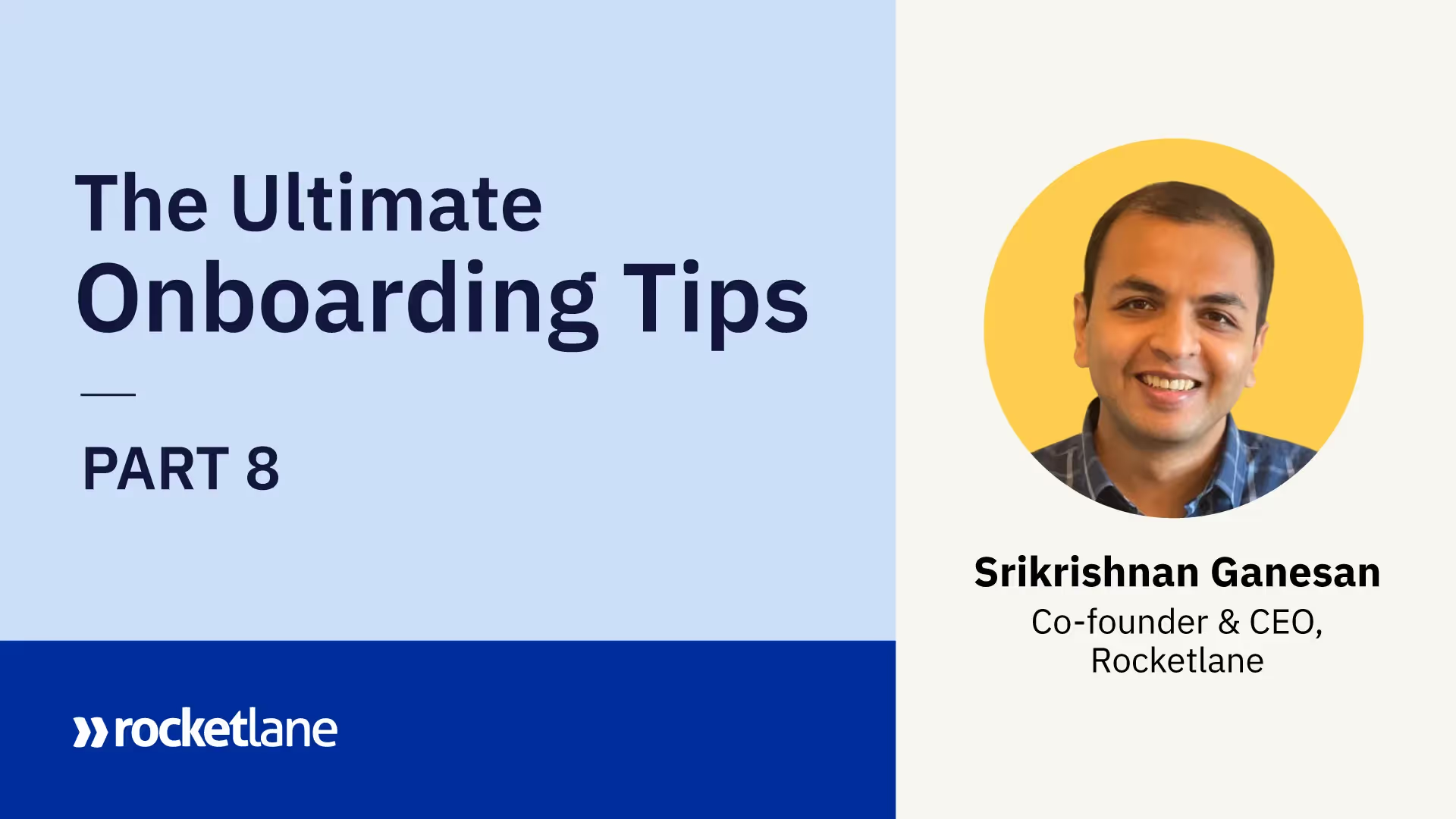Welcome to Part VIII of the Customer Onboarding Tips series. In part VII, we discussed why you should have an Onboarding Enablement Package, Business Reviews, and more.
In this installment, we’ll learn how peer pressure can work as a tactic to get your customers moving, why cut-over plans are important, and discuss handoff calls.
We hope you’re taking notes!
Tip #36: Peer pressure as a tactic
Onboarding is mostly about getting customers to engage and move at the pace we want them to. This tip will help you get your customers to act faster. It comes straight from an input Katie Clark shared during the Q&A session during her Implementation Stories session.
It's all about using "peer pressure" to move things forward faster. Your customers always want to know if their competitors or other companies are doing something better than them. They want to ensure they derive as much value from you as others, if not more. Aspirationally, they want to be your best implementation!
So how do you achieve this?
Maintain a list of customers who started onboarding with you around the same time. You can always tell the folks in the last 25th percentile about the speed at which others from their cohort have progressed, so they feel like they shouldn't be the laggards.
For example, PartnerStack tells customers who haven't finished onboarding on time about how others in their cohort have already graduated (PartnerStack has the merchants coming onboard with them "graduate" from their onboarding) and finding value.
No one wants to be at the bottom of the list and should be motivated to move faster to avoid that shame-inducing distinction. So the comparison and the peer pressure nudge them to move faster.
Do you have other ways of delivering a better onboarding experience or getting customers to value faster? Do share your ideas with us at care@rocketlane.com!
Tip #37: The cut-over plan
A common issue during onboarding a new customer is that when you replace a homegrown system or a generic tool (like a spreadsheet), you may still find many team members using their old systems or way of working, even months after you've actually onboarded them. A full transition has still not happened, and the goalpost keeps moving.
So how do you ensure the entire team adopts the new way of working and moves to your offering?
- Please don't leave it to them. Make a plan, or if the customer wants control (often the case with large teams), ask them to provide you with a cut-over plan which suits their organization.
- Make this something they need to provide and sign off on as part of your onboarding plan. This enables you to hold them to the plan and ensure the transition happens.
- If your software is for a function, ensure that reviews and dashboards for the function are purely run on your product.
- Check-in with them two weeks after the cut-over and measure adoption.
Try this out in your next onboarding, and let us know how it goes!
Tip #38: Make your customer POC a hero!
We often talk about how we want to be "partners" and not "vendors" for our customers. And yet, we find situations during onboarding where our customer POC is not moving things along at the right pace, and we have to point fingers or escalate to get work done. Where does that leave us with them? Are we going to have a smooth partnership when the POC starts feeling a lack of partnership with them or when we've thrown them under the bus?
In the ideal world, the onboarding is planned in a way that makes our customer POC successful - helping showcase them as the project's hero. That puts you in a strong place to move the partnership forward faster. Everyone has confidence and trust in each other, which is a win-win outcome.
How can you make your customer POC a hero? Here are some ideas:
- Prepare them for the timelines, and highlight key risks so they know what they may need to have an extra focus around to prevent slippage in timelines.
- Discuss and finalize the plan and timelines in discussion with the POC so they are entirely on the same page and aligned.
- Provide them with inputs, materials, best practices that help them do their role best, and ways they can work around identified risks.
- If they need help from their organization to get key activities done along the way, assist them with inputs and ideas on how they can hold their team accountable for the timely completion of those activities.
- Help them automate their internal teams' follow-ups, reminders, and status updates to save them energy and keep things on track.
- Have a few dimensions along which you can identify their contribution to completing a successful onboarding, and write to their bosses highlighting how well they've done on those.
- Highlight every win that comes from their efforts with communication to the whole team
What else do you do to highlight and make a hero out of your customer POC? Let us know at care@rocketlane.com
Tip #39: The Hand-off Call
As a customer success or implementation manager, have you ever been introduced to the customer over an email, gotten the time blocked with them, and struggled to get the right inputs from the sales and SE team till an hour before your first kick-off or intro call with the customer? Or ever struggled to get the hand-off document filled with quality inputs from the sales/SE team to the implementation team?
When this happens, you may miss out on an important detail, go semi-prepared for your first customer call, and have a surprise waiting for you. It never helps to find an important detail or goal you hadn't planned for while on call. Also, it never helps to ask customers questions they've already answered through the sales cycle.
It makes your team look less professional, and you can, of course, imagine a much better start to the relationship with the customer when you go in fully prepared and demonstrate that you are on top of things to help them with their goals. We all know first impressions matter.
One way to create a forcing function for this hand-off to happen well is to create a 15-minute "hand-off call," where you get together with sales and solution engineers and get all the info you need from them. Go synchronous rather than asynchronous since it is critical you get as many details ahead of time and get to prepare for your first call with that customer. Make it part of your process till those documents start getting much better!
Even if you have the notes from the sales calls and the sales team has filled out some details on your hand-off document or form, it helps to do this call just so that you can ask all your level-2 questions to your team first. If they already have answers for them, you avoid asking customers the same questions again! And over time, the team will also start adding those details to the document.
Here's how an internal hand-off call helps:
- You get to clarify doubts about what was indicated in the hand-off document or form.
- You get to ask more questions and learn specific things about the customers' needs that may not have come out in the hand-off document. This may help you refine the hand-off questionnaire for the future.
- Sales and SEs can give you a little more color on specific people, their concerns and priorities, etc., if they aren't yet covered in your hand-off documents.
Note: If your company is highly process-driven and mature, you can add more questions and do all of this asynchronously through a more comprehensive form too. But when you can't make that work well, set up the hand-off call and make that part of your own process.
Tip #40: Weekly Onboarding Standup
Ever find out way too late that a customer is running many weeks late on their onboarding, and the customer is losing confidence in your product?
By week 4, the delays have snowballed into a big mess, and the executive sponsor on the customer side now believes you haven't been proactive enough. Sigh.
So how do we keep a closer tab on this and ensure we aren't letting things slip?
Run a 30-min weekly onboarding standup meeting with your team. Get team members in CS/Onboarding to come up with the status of every onboarding:
- Is it on track or delayed?
- How is the customer sentiment?
- How is customer engagement?
- Are there any internal dependencies?
- Any blockers or risks?
- Is the customer live with your offering?
- Is the customer acknowledging value yet?
- Are we sending regular updates?
You can run through the projects with delays, blockers, negative sentiment, low engagement, etc., and ask the team to discuss their plan for the week on those accounts.
Creating this forcing function to think about these aspects would help teams stay on top of all these dimensions for every account and would result in them strategizing their key next steps with customers. It also provides an avenue to identify patterns across customers and to brainstorm as a team - about solutions to top problems/scenarios.
This ensures we are bringing down time-to-value across all our customers.
Have feedback or other ideas around improving onboarding? Feel free to write to us at care@rocketlane.com















